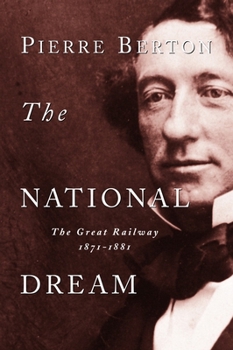The National Dream: The Great Railway, 1871-1881
Select Format
Select Condition 
Book Overview
In 1871, a tiny nation, just four years old -- it's population well below the 4 million mark -- determined that it would build the world's longest railroad across empty country, much of it unexplored. This decision -- bold to the point of recklessness -- was to change the lives of every man, woman and child in Canada and alter the shape of the nation. Using primary sources -- diaries, letters, unpublished manuscripts, public documents and newspapers -- Pierre Berton has reconstructed the incredible decade of the 1870s, when Canadians of every stripe -- contractors, politicians, financiers, surveyors, workingmen, journalists and entrepreneurs -- fought for the railway, or against it. The National Dream is above all else the story of people. It is the story of George McMullen, the brash young promoter who tried to blackmail the Prime Minister; of Marcus Smith, the crusty surveyor, so suspicious of authority he thought the Governor General was speculating in railway lands; of Sanford Fleming, the great engineer who invented Standard Time but who couldn't make up his mind about the best route for the railway. All these figures, and dozens more, including the political leaders of the era, come to life with all their human ambitions and failings.
Format:Paperback
Language:English
ISBN:0385658400
ISBN13:9780385658409
Release Date:August 2001
Publisher:Anchor Canada
Length:464 Pages
Weight:1.21 lbs.
Dimensions:1.3" x 6.1" x 9.0"
Related Subjects
Americas Business Business & Investing Canada Economics History Railroads TransportationCustomer Reviews
1 rating
Classic history of Canada's teething days
Published by Thriftbooks.com User , 21 years ago
Pierre Berton is Canada's favourite historian and this book remains the definitive history of the railroad that ensured Canada would grow all the way to the Pacific coast. The National Dream is the first of two chronicles. It recounts the preparations to the actual construction work, which is covered in the second volume "The Last Spike". We read of the political negotiations with British Columbia, which at first only wanted a wagon trail. We witness the fighting between the surveyors of different routes through the Rockies. I was surprised to discover that the greatest political difficulty was getting the railroad to go through Ontario, over the desolate granit of the Canadian shield, so that it avoid going south of the lakes, through the US. The Pacific railway had to be an all-Canadian venture. Still in politics, Berton describes the money politics of 1870's and ends by putting us in the House of Commons during the CPR debates of December 1880. Canada today is a country stretching from the Atlantic to the Pacific, capping the lower 48 of the United States. At Confederation in 1867, Canada ended at the Great Lakes; west of there but not part of Canada was the Hudson's Bay Company's land, the Red River colony (today Manitoba) and British Columbia. Canadian visionaries correctly saw the railway as the only way to ensure Canada survived American expansion. The CPR was a ridiculous undertaking. Imagine a country the size of New Zealand deciding that survival meant a space program and you get the picture. The CPR was an instance of a particularly Canadian National Policy whose purpose is to keep Canada whole. The price we had to pay then was that expensive all Canadian route. Interestingly, we still live with the legacy and expensive transportation is still a Canadian "feature". While travel between cities is cheap within the US, flights between any two large Canadian city are expensive as the money is used to subsidize transport to Canada's more remote areas. Is it worth it? Ask any Canadian, and you'll often get a mumble and grumble finally ending in a painful "yes, yes it is".





